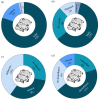Viewing the rare through public lenses: insights into dead calf carrying and other thanatological responses in Asian elephants using YouTube videos
- PMID: 35620003
- PMCID: PMC9114935
- DOI: 10.1098/rsos.211740
Viewing the rare through public lenses: insights into dead calf carrying and other thanatological responses in Asian elephants using YouTube videos
Abstract
Documenting the behavioural repertoire of an animal species is important for understanding that species' natural history. Many behaviours such as mating, parturition and death may be observed only rarely in the wild due to the low frequency of occurrence, short duration and the species' elusiveness. Opportunistic documentation of rare behaviours is therefore valuable for deciphering the behavioural complexity in a species. In this context, digital platforms may serve as useful data sources for studying rare behaviours in animals. Using videos uploaded on YouTube, we document and construct a tentative repertoire of thanatological responses (death-related behaviours) in Asian elephants (Elephas maximus). The most frequently observed thanatological responses included postural changes, guarding/keeping vigil, touching, investigating the carcass, epimeletic behaviours and vocalizations. We also describe some infrequently observed behaviours, including carrying dead calves by adult females, re-assurance-like behaviours and attempts to support dying or dead conspecifics, some of which were only known anecdotally in Asian elephants. Our observations indicate the significance of open-source video data on digital platforms for gaining insights into rarely observed behaviours and support the accumulating evidence for higher cognitive abilities of Asian elephants in the context of comparative thanatology.
Keywords: Elephas maximus; YouTube; carcass carrying; death reactions; rare behaviour; thanatology.
© 2022 The Authors.
Conflict of interest statement
We declare we have no competing interests.
Figures




Similar articles
-
Behavioural responses of free-ranging Asian elephants (Elephas maximus) towards dying and dead conspecifics.Primates. 2020 Jan;61(1):129-138. doi: 10.1007/s10329-019-00739-8. Epub 2019 Aug 19. Primates. 2020. PMID: 31428950
-
Death among primates: a critical review of non-human primate interactions towards their dead and dying.Biol Rev Camb Philos Soc. 2019 Aug;94(4):1502-1529. doi: 10.1111/brv.12512. Epub 2019 Apr 4. Biol Rev Camb Philos Soc. 2019. PMID: 30950189 Review.
-
Whale and dolphin behavioural responses to dead conspecifics.Zoology (Jena). 2018 Jun;128:1-15. doi: 10.1016/j.zool.2018.05.003. Epub 2018 May 9. Zoology (Jena). 2018. PMID: 29801996 Review.
-
Elephant behavior toward the dead: A review and insights from field observations.Primates. 2020 Jan;61(1):119-128. doi: 10.1007/s10329-019-00766-5. Epub 2019 Nov 11. Primates. 2020. PMID: 31713106
-
REPRODUCTIVE PARAMETERS AND BIRTH STATISTICS FOR A HERD OF ASIAN ELEPHANTS ( ELEPHAS MAXIMUS) IN NORTH AMERICA OVER A 20-YEAR PERIOD.J Zoo Wildl Med. 2017 Dec;48(4):987-996. doi: 10.1638/2017-0035.1. J Zoo Wildl Med. 2017. PMID: 29297839
Cited by
-
Leveraging social media and other online data to study animal behavior.PLoS Biol. 2024 Aug 29;22(8):e3002793. doi: 10.1371/journal.pbio.3002793. eCollection 2024 Aug. PLoS Biol. 2024. PMID: 39208351 Free PMC article.
-
Do elephants really never forget? What we know about elephant memory and a call for further investigation.Learn Behav. 2025 Mar;53(1):44-64. doi: 10.3758/s13420-024-00655-y. Epub 2024 Oct 22. Learn Behav. 2025. PMID: 39438402 Review.
-
Knowledge transmission, culture and the consequences of social disruption in wild elephants.Philos Trans R Soc Lond B Biol Sci. 2025 May;380(1925):20240132. doi: 10.1098/rstb.2024.0132. Epub 2025 May 1. Philos Trans R Soc Lond B Biol Sci. 2025. PMID: 40308137 Free PMC article.
-
Necrophilic behaviour in wild stump-tailed macaques (Macaca arctoides).Sci Rep. 2024 May 13;14(1):10946. doi: 10.1038/s41598-024-61678-z. Sci Rep. 2024. PMID: 38740882 Free PMC article.
-
Evidence of self-care tooling and phylogenetic modeling reveal parrot tool use is not rare.iScience. 2025 Mar 4;28(4):112156. doi: 10.1016/j.isci.2025.112156. eCollection 2025 Apr 18. iScience. 2025. PMID: 40171485 Free PMC article.
References
-
- Tewksbury JJ, et al. 2014. Natural history's place in science and society. Bioscience 64, 300-310. (10.1093/biosci/biu032) - DOI
-
- Lewis JS, Spaulding S, Swanson H, Keeley W, Gramza AR, VandeWoude S, Crooks KR. 2021. Human activity influences wildlife populations and activity patterns: implications for spatial and temporal refuges. Ecosphere 12, e03487. (10.1002/ECS2.3487) - DOI
-
- Nash LT. 1974. Parturition in a feral baboon (Papio anubis). Primates 15, 279-285. (10.1007/BF01742289) - DOI
Associated data
LinkOut - more resources
Full Text Sources

